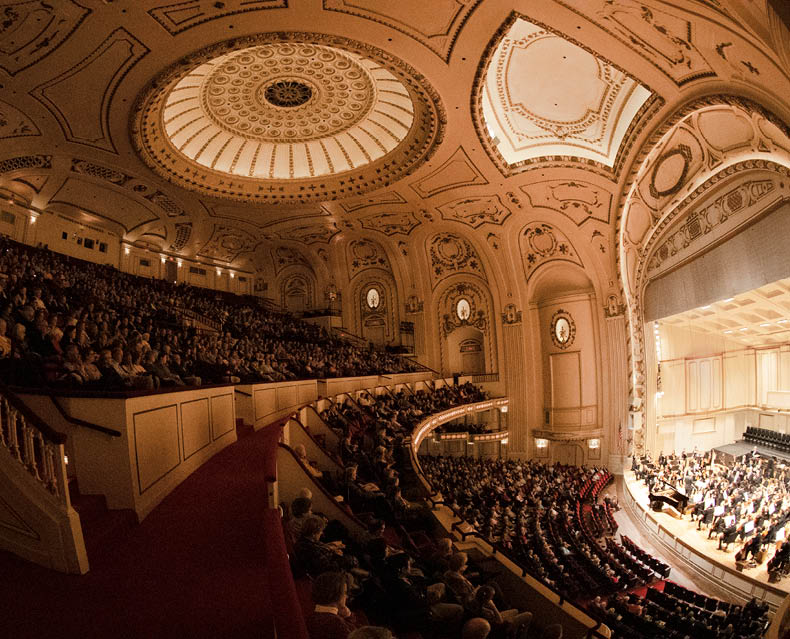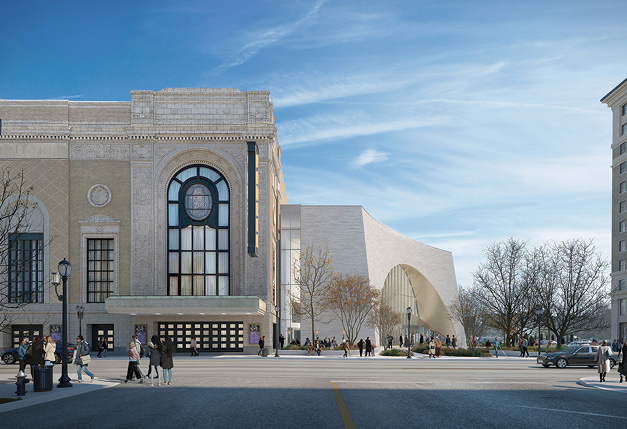
Powell Hall History
Erected in 1925 as the St. Louis Theatre, the building now known as Powell Hall was acquired by the St. Louis Symphony Society in 1966. It has served as the home of the St. Louis Symphony Orchestra since 1968.

Powell Hall Project
We’re renovating and expanding the nearly 100-year-old building to preserve and enhance our civic treasure for generations to come.
This project is inspired by you: our goal is to provide greater access to music, an even more welcoming and comfortable experience for all, and a creative hub that helps us build connections through the power of music.
Together with a team of world-class experts, we’ll transform the audience and artistic experience while protecting Powell Hall’s historic character and celebrated acoustics. A 65,000-square foot expansion will encompass a collection of new spaces designed to inspire deeper community connection and collaboration.
Erected in 1925 as the St. Louis Theatre, the building now known as Powell Hall was acquired by the St. Louis Symphony Society in 1966 through a $500,000 gift from Oscar Johnson, Jr., a longtime leader and benefactor of the Orchestra. Since its opening in November 1925, the St. Louis Theatre had presented the best in live vaudeville as well as motion pictures. Appropriately enough, The Sound of Music was the last movie shown in the old theater.
Following an extensive $2 million renovation, the St. Louis Symphony Orchestra was blessed with its first permanent home and one of the world’s finest concert halls. The 2,683-seat Powell Hall is named for Walter S. Powell, a St. Louis shoe manufacturing executive whose widow, Helen Lamb Powell, made the Symphony Society beneficiary of a $1 million charitable trust. These funds helped to match a $2 million Ford Foundation grant for the endowment of the new concert hall.
A team of internationally recognized architectural and acoustical specialists was assembled for the highly specialized work of renovating the former movie palace. Members of the St. Louis architectural firm of Wedemeyer, Cernik & Corrubia served as principal architects; David Mintz was engaged as lighting engineer; and Ben Schlanger, a theater architecture specialist who had just completed work on the new Metropolitan Opera House in New York City’s Lincoln Center, was consulted on such issues as sightlines, exits, service facilities, and the hall’s general configuration.
Through Mr. Schlanger, the Symphony was able to enlist the nationally renowned acoustician Dr. Cyril Harris to coordinate the hall’s acoustical reconstruction. Dr. Harris was also responsible for the acoustical engineering of the concert hall and opera house of the John F. Kennedy Center for the Performing Arts in Washington, D.C.
After the opening of Powell Hall on January 24, 1968, musicians and critics alike reacted with enthusiastic praise. Harold Schonberg, music critic for The New York Times, wrote: “Working with traditional means, [Cyril] Harris managed to obtain traditional sound-rich, full, detailed, with plenty of bass and extraordinary presence…a hall in which it is a pleasure to listen to music.”
Violinist Isaac Stern, following his performance in the first subscription concerts at Powell Hall, said: “It has warmth that enhances a performance…a pleasure for a musician. Powell Hall is first-rate. It ranks with Carnegie Hall in New York and Symphony Hall in Boston.”
Originally designed by the Chicago-based architectural firm of Rapp & Rapp, Powell Hall reflects European elegance in the classic red, gold, and cream decor of the Wightman Grand Foyer, modeled after the royal chapel at Versailles. The stained-glass window in the front facade features an image of Saint Louis IX, King of France, on horseback-a spectacular sight on concert evenings, when it is illuminated. The genuine feeling of tradition throughout the hall is appropriate for the nation’s second-oldest symphony orchestra.
During the 1980s, several theaters in close proximity to Powell Hall, including the Fox Theatre and the Sheldon Memorial Concert Hall, were renovated. By the end of that decade, a major initiative to revitalize the area had evolved into the Grand Center Redevelopment Project, a multi-million-dollar performing arts district, of which Powell Hall is a focal point.
Entered in the National Register of Historic Places in May 2001, Powell Hall stands as a testament not only to the leadership and foresight of those who made its acquisition and renovation possible, but to the cultural heritage of St. Louis and the city’s ability to renew and reinvent itself in the face of changing times, tastes, and trends.